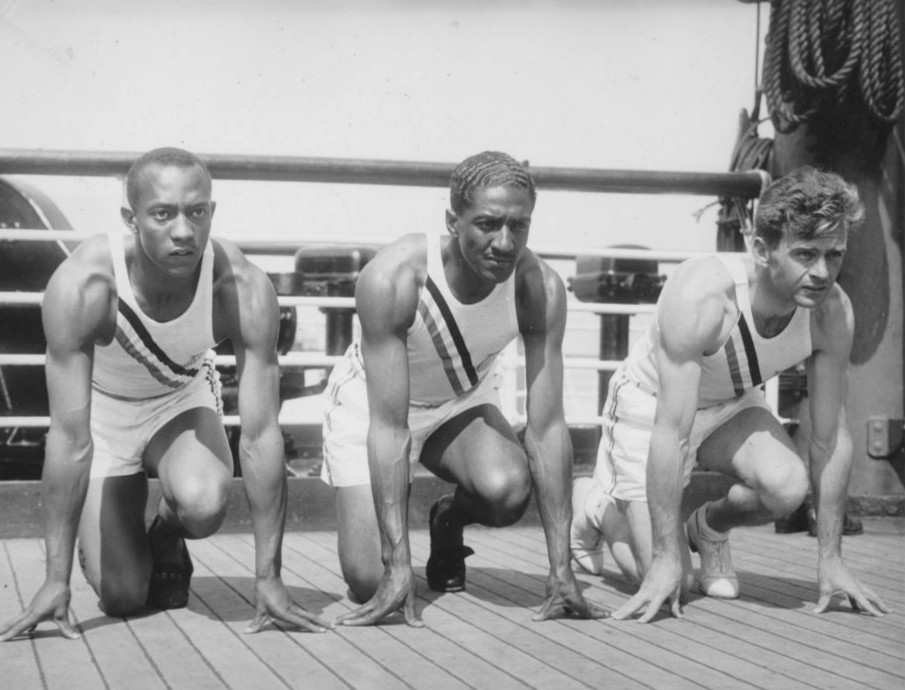|
Fully Automatic Timing
Fully automatic time (abbreviated FAT) is a form of race timing in which the clock is automatically activated by the starting device, and the finish time is either automatically recorded, or timed by analysis of a photo finish. The system is commonly used in track and field as well as athletic performance testing, horse racing, dog racing, bicycle racing, rowing and auto racing. In these fields a photo finish is used. It is also used in competitive swimming, for which the swimmers themselves record a finish time by touching a touchpad at the end of a race. In order to verify the equipment, or in case of failure, a backup system (typically manual) is usually used in addition to FAT. Technology In races started by a starting pistol, a sensor is typically attached to the gun which sends an electronic signal to the timing system when fired. An alternative starting light or sound which is electronically triggered, such as a horn, is typically also wired to the timing system. In sports ... [...More Info...] [...Related Items...] OR: [Wikipedia] [Google] [Baidu] |
Panorama
A panorama (formed from Greek πᾶν "all" + ὅραμα "view") is any wide-angle view or representation of a physical space, whether in painting, drawing, photography, film, seismic images, or 3D modeling. The word was originally coined in the 18th century by the English (Irish descent) painter Robert Barker to describe his panoramic paintings of Edinburgh and London. The motion-picture term ''panning'' is derived from ''panorama''. A panoramic view is also purposed for multimedia, cross-scale applications to an outline overview (from a distance) along and across repositories. This so-called "cognitive panorama" is a panoramic view over, and a combination of, cognitive spaces used to capture the larger scale. History The device of the panorama existed in painting, particularly in murals, as early as 20 A.D., in those found in Pompeii, as a means of generating an immersive "panoptic" experience of a vista. Cartographic experiments during the Enlightenment era prec ... [...More Info...] [...Related Items...] OR: [Wikipedia] [Google] [Baidu] |
Ralph Metcalfe
Ralph Harold Metcalfe Sr. (May 29, 1910 – October 10, 1978) was an American track and field sprinter and politician. He jointly held the world record in the 100-meter dash and placed second in that event in two Olympics, first to Eddie Tolan in 1932 at Los Angeles and then to Jesse Owens at the 1936 Olympics in Berlin, Germany. Metcalfe won four Olympic medals and was regarded as the world's fastest human in 1934 and 1935. He later went into politics in the city of Chicago and served in the United States Congress for four terms in the 1970s as a Democrat from Illinois. Track and field career Born in Atlanta, Georgia, Metcalfe grew up in Chicago and graduated high school from Tilden Tech in 1930. He accepted a track scholarship to Marquette University in Milwaukee, Wisconsin, and equaled the record of 10.3 seconds in the 100 m on a number of occasions, as well as equaling the 200 metres, 200 m record of 20.6 seconds. He became the first man to win the NCAA 200 m ... [...More Info...] [...Related Items...] OR: [Wikipedia] [Google] [Baidu] |
Gustavus Town Kirby
Gustavus Town Kirby (January 22, 1874 - February 28, 1956) was the president of the Amateur Athletic Union from 1911 to 1913. He was on every United States Olympic Committee from 1896 to 1956. He was chairman of the advisory committee for the Intercollegiate Association of Amateur Athletes of America from 1896 to 1928. Biography He was born on January 22, 1874, in Philadelphia, Pennsylvania. He attended Columbia University, where he was on the track team from 1893 to 1895. While in college he organized a committee to send athletes to the 1896 Summer Olympics. He then attended Columbia University Law School. In 1896 he won the Intercollegiate Fencing Association championship. Around 1912 he married Wilhelmine Stewart Dunn-Claflin (1885–1941). He was president of the United States Olympic Committee for the 1920 Summer Olympics and the chairman for the 1924 Summer Olympics. He became a widower in 1941 when his wife died at the LeRoy Sanitarium in New York City. He died i ... [...More Info...] [...Related Items...] OR: [Wikipedia] [Google] [Baidu] |
400 M
The 400 metres, or 400-meter dash, is a sprint event in track and field competitions. It has been featured in the athletics programme at the Summer Olympics since 1896 for men and since 1964 for women. On a standard outdoor running track, it is one lap around the track. Runners start in staggered positions and race in separate lanes for the entire course. In many countries, athletes previously competed in the 440-yard dash (402.336 m)—which is a quarter of a mile and was referred to as the 'quarter-mile'—instead of the 400 m (437.445 yards), though this distance is now obsolete. Like other sprint disciplines, the 400 m involves the use of starting blocks. The runners take up position in the blocks on the 'ready' command, adopt a more efficient starting posture which isometrically preloads their muscles on the 'set' command, and stride forwards from the blocks upon hearing the starter's pistol. The blocks allow the runners to begin more powerfully and the ... [...More Info...] [...Related Items...] OR: [Wikipedia] [Google] [Baidu] |
200 M
The 200 metres, or 200-meter dash, is a sprint running event. On an outdoor 400 metre racetrack, the race begins on the curve and ends on the home straight, so a combination of techniques is needed to successfully run the race. A slightly shorter race, called the '' stadion'' and run on a straight track, was the first recorded event at the ancient Olympic Games. The 200 m places more emphasis on speed endurance than shorter sprint distances as athletes predominantly rely on anaerobic energy system during the 200 m sprint. Similarly to other sprint distances, the 200 m begins from the starting blocks. When the sprinters adopt the 'set' position in the blocks they are able to adopt a more efficient starting posture and isometrically preload their muscles. This enables them to stride forwards more powerfully when the race begins and start faster. In the United States and elsewhere, athletes previously ran the 220-yard dash (201.168 m) instead of the 200 m (21 ... [...More Info...] [...Related Items...] OR: [Wikipedia] [Google] [Baidu] |
100 M
1 (one, unit, unity) is a number representing a single or the only entity. 1 is also a numerical digit and represents a single unit of counting or measurement. For example, a line segment of ''unit length'' is a line segment of length 1. In conventions of sign where zero is considered neither positive nor negative, 1 is the first and smallest positive integer. It is also sometimes considered the first of the infinite sequence of natural numbers, followed by 2, although by other definitions 1 is the second natural number, following 0. The fundamental mathematical property of 1 is to be a multiplicative identity, meaning that any number multiplied by 1 equals the same number. Most if not all properties of 1 can be deduced from this. In advanced mathematics, a multiplicative identity is often denoted 1, even if it is not a number. 1 is by convention not considered a prime number; this was not universally accepted until the mid-20th century. Additionally, 1 is the ... [...More Info...] [...Related Items...] OR: [Wikipedia] [Google] [Baidu] |
Sprint (running)
Sprinting is running over a short distance at the top-most speed of the body in a limited period of time. It is used in many sports that incorporate running, typically as a way of quickly reaching a target or goal, or avoiding or catching an opponent. Human physiology dictates that a runner's near-top speed cannot be maintained for more than 30–35 seconds due to the depletion of phosphocreatine stores in muscles, and perhaps secondarily to excessive metabolic acidosis as a result of anaerobic glycolysis. In athletics and track and field, sprints (or dashes) are races over short distances. They are among the oldest running competitions, being recorded at the Ancient Olympic Games. Three sprints are currently held at the modern Summer Olympics and outdoor World Championships: the 100 metres, 200 metres, and 400 metres. At the professional level, sprinters begin the race by assuming a crouching position in the starting blocks before driving forward and gradually moving into an ... [...More Info...] [...Related Items...] OR: [Wikipedia] [Google] [Baidu] |
World Records In Athletics
World records in athletics are ratified by World Athletics. Athletics records comprise the best performances in the sports of track and field, road running and racewalking. Records are kept for all events contested at the Olympic Games and some others. Unofficial records for some other events are kept by track and field statisticians. The only non-metric track distance for which official records are kept is the mile run. Criteria The criteria which must be satisfied for ratification of a world record are defined by World Athletics in Part III of the Competition Rules. These criteria also apply to national or other restricted records and also to performances submitted as qualifying marks for eligibility to compete in major events such as the Olympic Games. The criteria include: * The dimensions of the track and equipment used must conform to standards. In road events, the course must be accurately measured, by a certified measurer. * Except in road events (road running and race ... [...More Info...] [...Related Items...] OR: [Wikipedia] [Google] [Baidu] |
IAAF
World Athletics, formerly known as the International Amateur Athletic Federation (from 1912 to 2001) and International Association of Athletics Federations (from 2001 to 2019, both abbreviated as the IAAF) is the international governing body for the sport of athletics, covering track and field, cross country running, road running, race walking, mountain running, and ultra running. Included in its charge are the standardization of rules and regulations for the sports, certification of athletic facilities, recognition and management of world records, and the organisation and sanctioning of athletics competitions, including the World Athletics Championships. The organisation's president is Sebastian Coe of the United Kingdom, who was elected in 2015 and re-elected unopposed in 2019 for a further four years. World Athletics suspended the Russian Athletics Federation (RusAF) from World Athletics starting in 2015, for eight years, due to doping violations, making it ineligible to hos ... [...More Info...] [...Related Items...] OR: [Wikipedia] [Google] [Baidu] |





